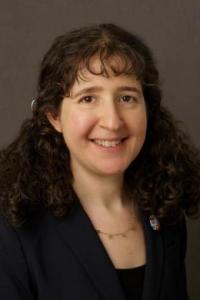Laura Landweber, PhD
- Professor of Biochemistry and Molecular Biophysics
- Professor of Biological Sciences (Columbia University)

Overview
Laura Landweber is a Professor in the Departments of Biochemistry & Molecular Biophysics, Biological Sciences, and Systems Biology, in the Colleges of Physicians & Surgeons and Arts & Sciences. Prior to moving her lab to Columbia University Medical Center she was faculty at Princeton University from 1994-2016, and a Junior Fellow of the Society of Fellows at Harvard University, where she received her PhD in 1993. She has authored over 150 publications in molecular and evolutionary biology and edited 3 books, in areas ranging from genetics and evolution to biological computation. She is President (2017) of the Society for Molecular Biology and Evolution (SMBE) and has served on several panels, working groups, and advisory committees for the NSF, NIH, and NASA, including co-chairing the NHGRI Comparative Genome Evolution Working Group from 2003-2007. Recent awards include a Guggenheim fellowship (2012) and a Blavatnik award for young scientists (2008), and she was elected a Fellow of AAAS for probing the diversity of genetic systems in microbial eukaryotes, including scrambled genes, RNA editing, variant genetic codes, and comparative genomics. Her work investigates the origin of novel genetic systems and complex genome architectures, using the ciliate Oxytricha as a model. Recent discoveries include the ability of small and long non-coding RNA molecules to program genome organization across generations, bypassing the information encoded in DNA.
A recent profile of Dr. Landweber's work can be found at:
https://systemsbiology.columbia.edu/news/qa-with-dr-laura-landweber
Academic Appointments
- Professor of Biochemistry and Molecular Biophysics
- Professor of Biological Sciences (Columbia University)
Gender
- Female
Credentials & Experience
Education & Training
- AB, 1989 Molecular Biology, Princeton University
- PhD, 1993 Harvard University
Honors & Awards
President, Society for Molecular Biology and Evolution, 2017
Guggenheim Fellow, 2012.
The New York Academy of Sciences, Blavatnik Award for Young Scientists, 2008
AAAS Fellow, 2005
Research
Research in the Landweber Lab focuses on microbial eukaryotes with complex genome architectures. We use both 1) functional genomic experiments that manipulate chromosome structure to study the roles of RNA in mediating epigenetic inheritance and genome programming, and 2) comparative genomic analysis to examine the origin and evolution of scrambled genome organization. The model organisms that we use have two nuclei, which permits comparative genomics within a single cell. One genome gives rise to the other during programmed genome reorganization, and we study how this system co-evolved with germline DNA transposons.
Research Interests
- Genome Evolution
- Genome Rearrangement
- Molecular Evolution
- Small and Long Noncoding RNAs
Selected Publications
Lindblad, K. A., Bracht, J. R., Williams, A. E. and L. F. Landweber (2017) Thousands of RNA-cached copies of whole chromosomes are present in the ciliate Oxytricha during development. RNA. doi: 10.1261/rna.058511.116
Bracht, J. R., Wang, X., Shetty, K., Chen, X., Uttarotai, G. J., Callihan, E. C., McCloud, S. S., Clay, D. M., Wang, J., Nowacki, M. and L. F. Landweber (2016). Chromosome fusions triggered by noncoding RNA. RNA Biology. doi: 10.1080/15476286.2016.1195940.
Chen, X., Jung, S., Beh, L. Y., Eddy, S. R., and L. F. Landweber (2015) Combinatorial DNA Rearrangement Facilitates the Origin of New Genes in Ciliates. Genome Biol Evol. 7(10):2859-70.
Beh, L. Y., Müller, M. M., Muir, T. W., Kaplan, N., and L. F. Landweber (2015) DNA-guided establishment of canonical nucleosome patterns within coding regions of a eukaryotic genome. Genome Research, 25:1727-1738.
Chen, X., Bracht, J. R., Goldman, A. D., Dolzhenko, E., Clay, D. M., Swart, E. C., Perlman, D. H., Sebra, R. P., Doak, T. G., Stuart, A., Amemiya, C. T., and L. F. Landweber (2014) The architecture of a scrambled genome reveals massive levels of genomic rearrangement during development. Cell, 158:1187-1198.
Bracht, J. R., Fang, W., Goldman, A. D., Dolzhenko, E., Stein, E. M., and L. F. Landweber (2013) Genomes on the edge: Programmed genome instability in ciliates. Cell, 152:406-16.
Swart, E. C., Bracht, J. R., Magrini, V., Minx, P., Chen, X., Zhou, Y., Khurana, J. S., Goldman, A. D., Nowacki, M., Schotanus, K., Jung, S., Fulton, R. S., Ly, A., McGrath, S., Haub, K., Buckles, J. L., Storton, D., Matese, J., Parsons, L., Chang, W.-J., Bowen, M. S., Stover, N. A., Jones, T. A., Eddy, S. R., Herrick, G. A., Doak, T. G., Wilson, R. K., Mardis, E. R., and L. F. Landweber (2013) The Oxytricha trifallax Macronuclear Genome: A Complex Eukaryotic Genome with 16,000 Tiny Chromosomes. PLoS Biology, 11(1): e1001473. (cover article)
Fang, W., Wang, X., Bracht, J. R., Nowacki, M., and L. F. Landweber (2012) Piwi-Interacting RNAs Protect DNA Against Loss During Oxytricha Genome Rearrangement. Cell, 151:1243-55.
Bracht, J. R., Perlman, D. H., and L. F. Landweber (2012) Cytosine methylation and hydroxymethylation mark DNA for elimination in Oxytricha trifallax. Genome Biology, 13, R99, http://genomebiology.com/2012/13/10/R99.
Nowacki, M., Haye, J. E., Fang, W., Vijayan, V. and L. F. Landweber (2010) RNA-mediated epigenetic regulation of DNA copy number. Proc Natl Acad Sci USA. 107:22140-4.
Nowacki, M., Higgins, B. P., Maquilan, G., Swart, E., Doak, T. G. and L. F. Landweber (2009) A functional role for transposases in a large eukaryotic genome. Science 324: 935-8.
Möllenbeck, M., Zhou, Y., Cavalcanti, A. R. O., Jönsson, F., Higgins, B. P., Chang, W.-J., Juranek, S., Doak, T. G., Rozenberg, G., Lipps, H. J. and L. F. Landweber (2008) The pathway to detangle a scrambled gene. PLoS ONE 3(6):e2330.
Nowacki, M., Vijayan, V., Zhou, Y., Schotanus, K., Doak, T. G. and L. F. Landweber (2008) RNA-mediated epigenetic programming of a genome-rearrangement pathway. Nature 451, 153-158.
Landweber, L. F. (2007) Why genomes in pieces? Science 318:405-407.
For a complete list of publications, please visit PubMed.gov